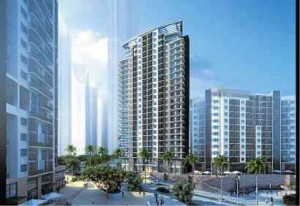Energy-saving Ortigas towers also ready for nature’s worst
TWO THINGS Mother Nature has taught us recently: One is to respect the Earth’s resources; the other is to respect her power.
Almost two years after typhoon “Ondoy” unleashed one of the worst floods in recent memory, and after powerful earthquakes rocked one part of the world after another, in the specter of a changing global climate, property developers find that they need to evolve the way they do their work before they could woo today’s well-informed and environmentally-conscious buyers.
Today’s brochures need to enumerate not only floor areas, lifestyle features, unit types and proximities to commercial centers. In equal measure, these will also have to convince the target market that the development possesses enough environmental merits to be sustainable and safe.
The Circulo Verde development is one such example.
Circulo Verde, a multitower commercial and residential project on Calle Industria, Bagumbayan, Quezon City, claims that its four towers of the Phase 1 project are nearly sold out, with a fifth tower—the Lleida—just recently launched. Part of the high-level sales takeup is credited to the developer’s emphasis on geographical preparations for the project including its seismic studies for earthquakes, hydrologic and flood study, technologies installed, use of natural and local materials, waste-water treatment facilities and solar designs.
Joey Santos, senior vice president for real estate division of Ortigas & Company, Limited Partnership (or OCLP, the developer of Circulo Verde), himself believes in the development that he was the first to buy a unit in Majorca (the first of the towers) as an investment for his kids. “The reason is simple: I was here from the conception of the master plan until now, when the first two towers are already undergoing structural works.”
Particularly, Santos cited seven reasons he decided to buy a unit here:
1 Geographic soundness ascertained. A comprehensive technical preengineering study involving tests such as soil boring was conducted by DCCD (Design Construction Consultancy Management and Development) to ascertain the geographic soundness of the site. A complete Eggar (Engineering Geological and Geohazard Assessment Report) was also prepared to determine site soundness in preparation for the proposed residential development.
2 Hydrological and flood study completed. OCLP commissioned DCCD Engineering, a company with 50 years of experience in hydrology and flood control for the studies.
3 Seismic studies ensure the development can withstand Intensity 8 earthquakes. OCLP has conducted seismic studies based on ground conditions and proximity to the fault system. During an earthquake, buildings would react in proportion to the stiffness of the structural members. The columns and beams of Circulo Verde are moment-resisting frames that, together with the shear walls, would resist the lateral forces induced by earthquakes.
“We could stand earthquakes with an intensity of up to 8 without major damage to structural members or collapse of structural load,” Santos said.
4 The design considered the Marikina West Valley Fault System with the latest edition of National Structural Code of the Philippines (NSCP-2001) and the Uniform Building Code (UBC) in mind. The Philippines is located in seismic Zone 4, as classified by the NSCP and UBC, which deems it similar to seismic vulnerability and intensity to the US state of California.
5 Flood protection through elevation, erosion prevention. The perimeter retaining wall built around Circulo Verde is designed to avoid soil erosion that may be caused by the currents of the Marikina River running alongside the development.
The entire site is raised eight meters above Marikina River.
The smart drainage system is an interceptor canal 1.50 meters by 1.50 meters, to be constructed along the northwestern boundary to intercept and convey the surface flow from Calle Industria and possible overflows from the Marikina River upstream of the Felix Manalo Bridge.
Parking spaces have been constructed above ground only to ensure vehicle safety. A backup pump system, in tandem with the detention tank system and automated pump system for flood mitigation, will be provided to adequately drain the storm water volume that may accumulate or be trapped inside the dike system.
6 Energy-saving features uses the sun. The tower units have window views that maximize solar gain. Hallways have been designed to have cross-ventilation systems. Indoor air quality has also been considered. Range hood and bath fans are vented to the outside, and operable windows are also installed in all units.
Waste management and wastewater treatment facilities have also been installed.
7 All materials are local. All materials used in the construction are locally found and are environment-friendly. These include floor finishes (with low toxin mortar and grout), paints with no or low volatile organic compounds, fomaldehyde-free cabinetry, no pressure-treated lumber, low toxicity or nonsolvent adhesives.
Largely because of these seven reasons, Majorca has been sold out, Ibiza is 70 percent sold (it has 44- to 80-sq m units, with prices ranging from P3.7 million to P6.9 million), Seville 68 percent sold (with 46 to 95-sq m units at prices from 3.7 million to P8.3 million). The newly launched Lleida offers 22-sq m to 91-sq m units with prices from P1.8 million to P8.1 million). Check out www.circuloverde.com.ph.

